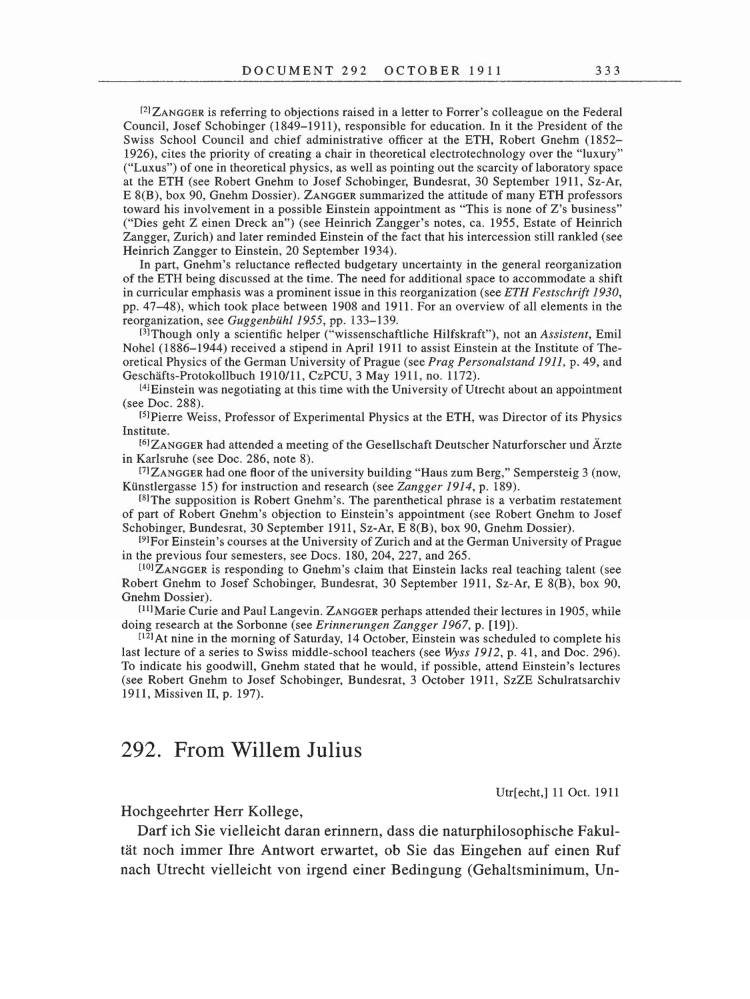DOCUMENT 292 OCTOBER 1911 333 [2]Zangger is referring to objections raised in a letter to Forrer's colleague on the Federal Council, Josef Schobinger (1849-1911), responsible for education. In it the President of the Swiss School Council and chief administrative officer at the ETH, Robert Gnehm (1852- 1926), cites the priority of creating a chair in theoretical electrotechnology over the "luxury" ("Luxus") of one in theoretical physics, as well as pointing out the scarcity of laboratory space at the ETH (see Robert Gnehm to Josef Schobinger, Bundesrat, 30 September 1911, Sz-Ar, E 8(B), box 90, Gnehm Dossier). Zangger summarized the attitude of many ETH professors toward his involvement in a possible Einstein appointment as "This is none of Z's business" ("Dies geht Z einen Dreck an") (see Heinrich Zangger's notes, ca. 1955, Estate of Heinrich Zangger, Zurich) and later reminded Einstein of the fact that his intercession still rankled (see Heinrich Zangger to Einstein, 20 September 1934). In part, Gnehm's reluctance reflected budgetary uncertainty in the general reorganization of the ETH being discussed at the time. The need for additional space to accommodate a shift in curricular emphasis was a prominent issue in this reorganization (see ETH Festschrift 1930, pp. 47-48), which took place between 1908 and 1911. For an overview of all elements in the reorganization, see Guggenbühl 1955, pp. 133-139. [3]Though only a scientific helper ("wissenschaftliche Hilfskraft"), not an Assistent, Emil Nohel (1886-1944) received a stipend in April 1911 to assist Einstein at the Institute of The- oretical Physics of the German University of Prague (see Prag Personalstand 1911, p. 49, and Geschäfts-Protokollbuch 1910/11, CzPCU, 3 May 1911, no. 1172). [4]Einstein was negotiating at this time with the University of Utrecht about an appointment (see Doc. 288). [5]Pierre Weiss, Professor of Experimental Physics at the ETH, was Director of its Physics Institute. [6]Zangger had attended a meeting of the Gesellschaft Deutscher Naturforscher und Ärzte in Karlsruhe (see Doc. 286, note 8). [7]Zangger had one floor of the university building "Haus zum Berg," Sempersteig 3 (now, Künstlergasse 15) for instruction and research (see Zangger 1914, p. 189). [8]The supposition is Robert Gnehm's. The parenthetical phrase is a verbatim restatement of part of Robert Gnehm's objection to Einstein's appointment (see Robert Gnehm to Josef Schobinger, Bundesrat, 30 September 1911, Sz-Ar, E 8(B), box 90, Gnehm Dossier). [9]For Einstein's courses at the University of Zurich and at the German University of Prague in the previous four semesters, see Docs. 180, 204, 227, and 265. [10]Zangger is responding to Gnehm's claim that Einstein lacks real teaching talent (see Robert Gnehm to Josef Schobinger, Bundesrat, 30 September 1911, Sz-Ar, E 8(B), box 90, Gnehm Dossier). [11]Marie Curie and Paul Langevin. Zangger perhaps attended their lectures in 1905, while doing research at the Sorbonne (see Erinnerungen Zangger 1967, p. [19]). [12]At nine in the morning of Saturday, 14 October, Einstein was scheduled to complete his last lecture of a series to Swiss middle-school teachers (see Wyss 1912, p. 41, and Doc. 296). To indicate his goodwill, Gnehm stated that he would, if possible, attend Einstein's lectures (see Robert Gnehm to Josef Schobinger, Bundesrat, 3 October 1911, SzZE Schulratsarchiv 1911, Missiven II, p. 197). 292. From Willem Julius Utr[echt,] 11 Oct. 1911 Hochgeehrter Herr Kollege, Darf ich Sie vielleicht daran erinnern, dass die naturphilosophische Fakul- tät noch immer Ihre Antwort erwartet, ob Sie das Eingehen auf einen Ruf nach Utrecht vielleicht von irgend einer Bedingung (Gehaltsminimum, Un-
